Introduction to the animation features¶
The AnimationPlayer node allows you to create anything from simple to complex animations.
In this guide you learn to:
Work with the Animation Panel
Animate any property of any node
Create a simple animation
Call functions with the powerful Call Function Tracks
In Godot, you can animate anything available in the Inspector, such as Node transforms, sprites, UI elements, particles, visibility and color of materials, and so on. You can also modify values of script variables and call any function.
Create an AnimationPlayer node¶
To use the animation tools we first have to create an AnimationPlayer node.
The AnimationPlayer node type is the data container for your animations. One AnimationPlayer node can hold multiple animations, that can automatically transition to one another.
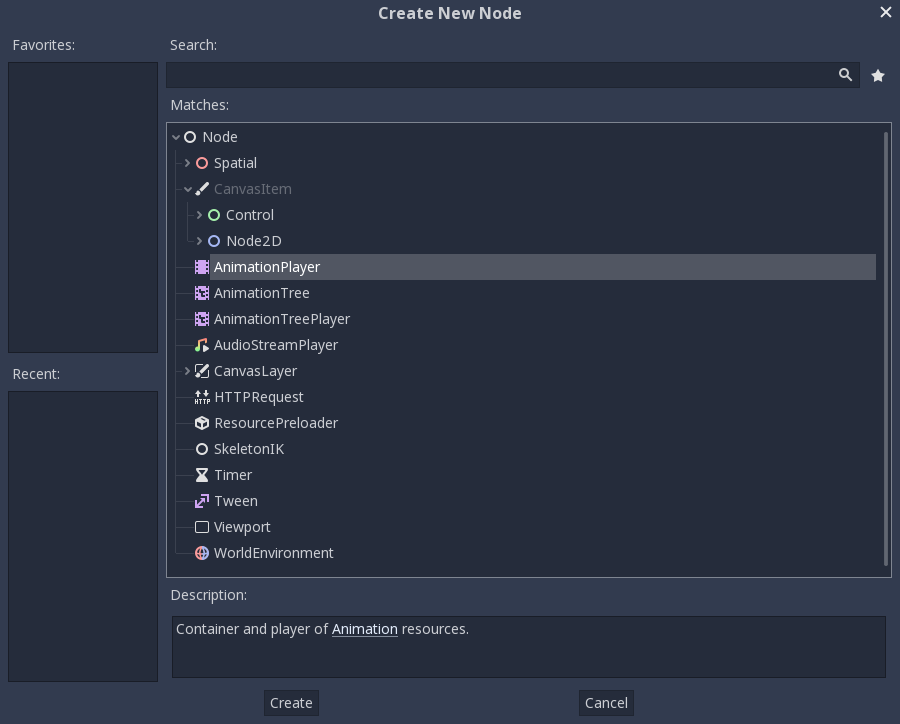
The AnimationPlayer node¶
After creating one click on the AnimationPlayer node in the Node tab to open the Animation Panel at the bottom of the viewport.

The animation panel position¶
It consists of four parts:

The animation panel¶
Animation controls (i.e. add, load, save, and delete animations)
The tracks listing
The timeline with keyframes
The timeline and track controls, where you can zoom the timeline and edit tracks for example.
Computer animation relies on keyframes¶
A keyframe defines the value of a property at a certain point in time.
Diamond shapes represent keyframes in the timeline. A line between two keyframes indicates that the value hasn't changed.

Keyframes in Godot¶
The engine interpolates values between keyframes, resulting in a gradual change in values over time.
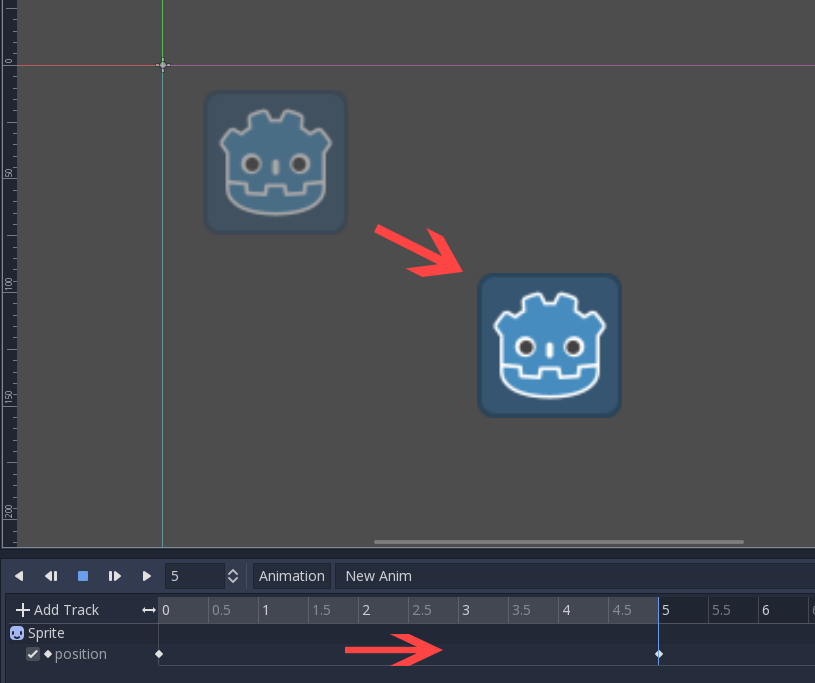
Two keyframes are all it takes to obtain a smooth motion¶
The timeline lets you insert keyframes and change their timing. It also defines how long the animation is.

The timeline in the animation panel¶
Each line of the Animation Panel is an animation track. Normal and Transform tracks reference node properties. Their name or id is a path to the node and the affected property.

Example of Normal animation tracks¶
Tip
If you animate the wrong property, you can edit a track's path anytime.
Double click on it and type the new path. Play the animation using the
"Play from beginning" button  (or pressing
Shift + D on keyboard) to see the changes instantly.
(or pressing
Shift + D on keyboard) to see the changes instantly.
Tutorial: Creating a simple animation¶
Scene setup¶
For this tutorial, we'll create a Sprite node with an AnimationPlayer as its child. We will animate the sprite to move between two points on the screen.
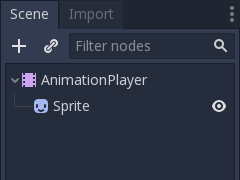
Our scene setup¶
Warning
AnimationPlayer inherits from Node instead of Node2D or Spatial, which means that the child nodes will not inherit the transform from the parent nodes due to a bare Node being present in the hierarchy.
Therefore, it is not recommended to add nodes that have a 2D/3D transform as a child of an AnimationPlayer node.
The sprite holds an image texture. We animate that sprite to move between two points on the screen. For this tutorial, use the default Godot icon as the sprite's texture. As a starting point, move the sprite to a left position on the screen.
Select the AnimationPlayer node, then click the "Animation" button in the
animation editor. From the list select "New" ( ) to add a new animation. And Enter a name for the animation in the
dialog box.
) to add a new animation. And Enter a name for the animation in the
dialog box.
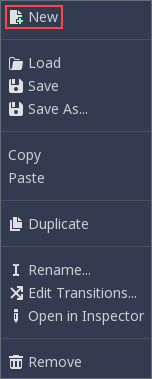
Add a new animation¶
Adding a track¶
To add a new track for our sprite, select it and take a look in the toolbar:

Convenience buttons¶
These switches and buttons allow you to add keyframes for the selected node's location, rotation, and scale respectively.
Deselect rotation, because we are only interested in the location of our sprite for this tutorial and click on the key button.
As we don't have a track already set up for the transform/location property, Godot asks whether it should set it up for us. Click Create.
This creates a new track and our first keyframe at the beginning of the timeline:

The sprite track¶
The second keyframe¶
Now we need to set the destination where our sprite should be headed and how much time it takes to get there.
Let's say, we want it to take 2 seconds to go to the other point. By default the animation is set to last only 1 second, so change this in the timeline controls in animation panel's lower panel to 2.

Animation length¶
Click on the timeline header near the 2-second mark and move the sprite to the target destination on the right side.
Again, click the key button in the toolbar. This creates our second keyframe.
Run the animation¶
Click on the "Play from beginning" ( ) button.
) button.
Yay! Our animation runs:

The animation¶
Back and forth¶
Godot has an additional feature here. Like said before, Godot always calculates the frames between two keyframes. In a loop, the first keyframe is also the last keyframe, if no keyframe is specified at the end.

Animation loop¶
If you set the animation length to 4 seconds now, the animation moves back and forth. You can change this behavior if you change the track's loop mode. This is covered in the next chapter.
Track settings¶
Each track has a settings panel at the end, where you can set the update mode, the track interpolation, and the loop mode.

Track settings¶
The update mode of a track tells Godot when to update the property values. This can be:
Continuous: Update the property on each frame.
Discrete: Only update the property on keyframes.
Trigger: Only update the property on keyframes or triggers. Triggers are a type of keyframe used by the
current_animationproperty of a AnimationPlayer, and Animation Playback tracks.Capture: If the first keyframe's time is greater than
0.0, the current value of the property will be remembered and will be blended with the first animation key. For example, you could use the Capture mode to move a node that's located anywhere to a specific location.

Track mode¶
In normal animations, you usually use "Continuous". The other types are used to script complex animations.
The interpolation tells Godot how to calculate the frame values between the keyframes. These interpolation modes are supported:
Nearest: Set the nearest keyframe value
Linear: Set the value based on a linear function calculation between the two keyframes
Cubic: Set the value based on a cubic function calculation between the two keyframes

Track interpolation¶
Cubic interpolation leads to a more natural movement, where the animation is slower at a keyframe and faster between keyframes. This is usually used for character animation. Linear interpolation creates more of a robotic movement.
Godot supports two loop modes, which affect the animation if it's set to loop:

Loop modes¶
Clamp loop interpolation: When this is selected, the animation stops after the last keyframe for this track. When the first keyframe is reached again, the animation will reset to its values.
Wrap loop interpolation: When this is selected, Godot calculates the animation after the last keyframe to reach the values of the first keyframe again.
Keyframes for other properties¶
Godot doesn't restrict you to only edit transform properties. Every property can be used as a track where you can set keyframes.
If you select your sprite while the animation panel is visible, you get a small keyframe button for all the sprite's properties. Click on this button and Godot automatically adds a track and keyframe to the current animation.
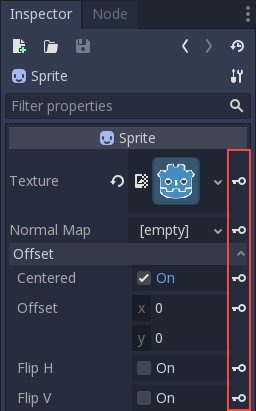
Keyframes for other properties¶
Edit keyframes¶
For advanced use and to edit keyframes in detail, You can click on them to bring up the keyframe editor in the inspector. You can use this to directly edit its values.

Keyframe editor editing a key¶
Additionally, you can also edit the easing value for this keyframe by clicking and dragging the easing setting. This tells Godot, how to change the property values when it reaches this keyframe.
You usually tweak your animations this way, when the movement doesn't "look right".
Advanced: Call Method tracks¶
Godot's animation engine doesn't stop here. If you're already comfortable with Godot's scripting language GDScript basics and All classes you know that each node type is a class and has a bunch of callable methods.
For example, the AudioStreamPlayer node type has a method to play an audio stream.
Wouldn't it be great to use a method at a specific keyframe in an animation? This is where "Call Method Tracks" come in handy. These tracks reference a node again, this time without a reference to a property. Instead, a keyframe holds the name and arguments of a method, that Godot should call when it reaches this keyframe.
To demonstrate, we're going to use a call method track to play audio at a specific keyframe. Normally to play audio you should use an audio track, but for the sake of demonstrating methods we're going to do it this way.
Add a AudioStreamPlayer to the Scene Tree and setup a stream using an audio file you put in your project.
Click on "Add track" ( ) on the animation panel's track
controls.
) on the animation panel's track
controls.
Select "Add Call Method Track" from the list of possible track types.
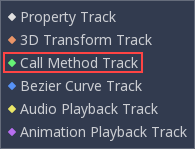
Add Call Method Track¶
Select the AudioStreamPlayer node in the selection window. Godot adds the track with the reference to the node.

Select AudioStreamPlayer¶
Right click the timeline where Godot should play the sample and click the "Insert Key" option. This will bring up a list of methods that can be called for the AudioStreamPlayer node. Select the first one.

When Godot reaches the keyframe, Godot calls the AudioStreamPlayer node's "play" function and the stream plays.
You can change its position by dragging it on the timeline, you can also click on the keyframe and use the keyframe settings in the inspector.
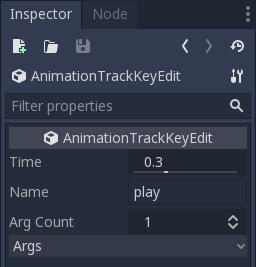
Using RESET tracks¶
You can set up a special RESET animation to contain the "default pose". This is used to ensure that the default pose is restored when you save the scene and open it again in the editor.
For existing tracks, you can add an animation called "RESET" (case-sensitive), then add tracks for each property that you want to reset. The only keyframe should be at time 0, and give it the desired default value for each track.
If AnimationPlayer's Reset On Save property is set to true,
the scene will be saved with the effects of the reset animation applied
(as if it had been seeked to time 0.0).
This only affects the saved file – the property tracks in the editor stay
where they were.
If you want to reset the tracks in the editor, select the AnimationPlayer node, open the Animation bottom panel then choose Apply Reset in the animation editor's Animation dropdown menu.
When adding tracks on new animations, the editor will ask you to automatically create a RESET track when using the keyframe icon next to a property in the inspector. This does not apply on tracks created with Godot versions prior to 3.4, as the animation reset track feature was added in 3.4.